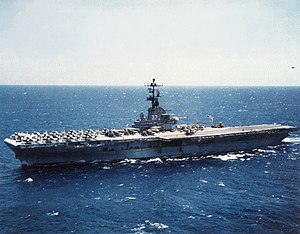
Back USS Kearsarge (CV-33) Czech Kearsarge (Schiff, 1946) German USS Kearsarge (CV-33) Spanish یواساس کیرسارگ (سیوی-۳۳) Persian USS Kearsarge (CV-33) French USS Kearsarge (CV-33) Croatian USS Kearsarge (CV-33) Italian キアサージ (空母) Japanese USS 키어사지 (CV-33) Korean USS Kearsarge (CV-33) Polish
 USS Kearsarge at sea in 1966
| |
| History | |
|---|---|
| Name | Kearsarge |
| Namesake | USS Kearsarge (1861) |
| Builder | New York Naval Shipyard |
| Laid down | 1 March 1944 |
| Launched | 5 May 1945 |
| Commissioned | 2 March 1946 |
| Decommissioned | 16 June 1950 |
| Recommissioned | 15 February 1952 |
| Decommissioned | 13 February 1970 |
| Reclassified |
|
| Stricken | May 1973 |
| Fate | Scrapped, February 1974 |
| General characteristics | |
| Class and type | Essex-class aircraft carrier |
| Displacement | 27,100 long tons (27,500 t) standard |
| Length | 888 feet (271 m) overall |
| Beam | 93 feet (28 m) |
| Draft | 28 feet 7 inches (8.71 m) |
| Installed power |
|
| Propulsion |
|
| Speed | 33 knots (61 km/h; 38 mph) |
| Complement | 3448 officers and enlisted |
| Armament | |
| Armor |
|
| Aircraft carried | 90–100 aircraft |
USS Kearsarge (CV/CVA/CVS-33) was one of 24 Essex-class aircraft carriers completed during or shortly after World War II for the United States Navy. The ship was the third US Navy ship to bear the name, and was named for a Civil War-era steam sloop. Kearsarge was commissioned in March 1946. Modernized in the early 1950s as an attack carrier (CVA), she served in the Korean War, for which she earned two battle stars. In the late 1950s she was further modified to become an anti-submarine carrier (CVS). Kearsarge was the recovery ship for the last two crewed Project Mercury space missions in 1962–1963. She completed her career serving in the Vietnam War, earning five battle stars.
She was decommissioned in 1970, and sold for scrap in 1974.